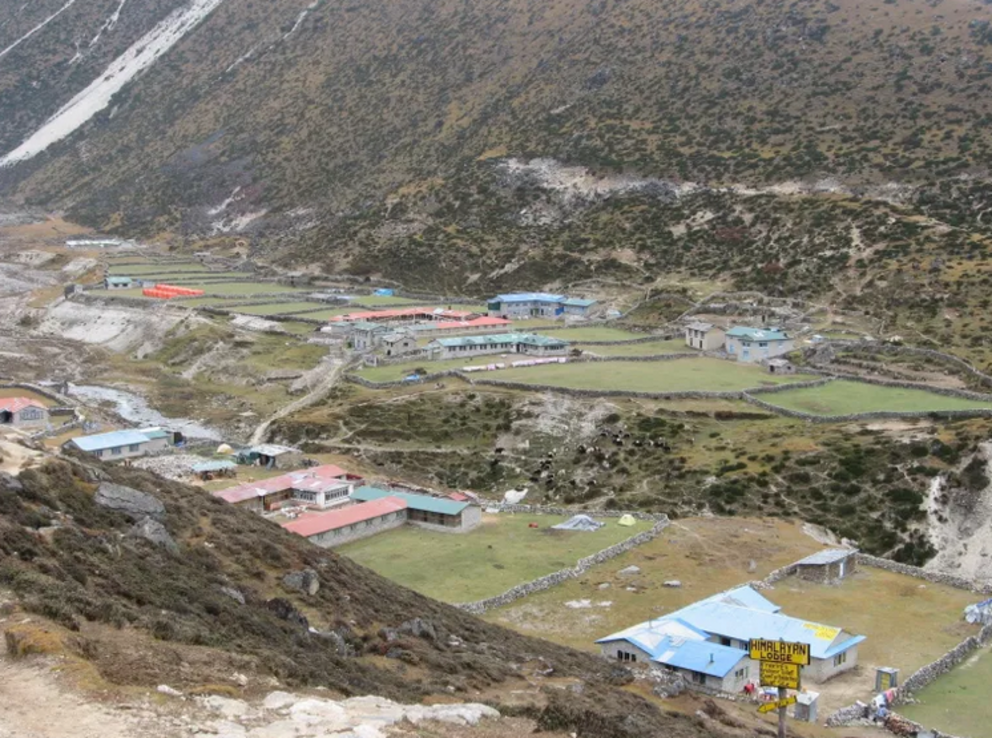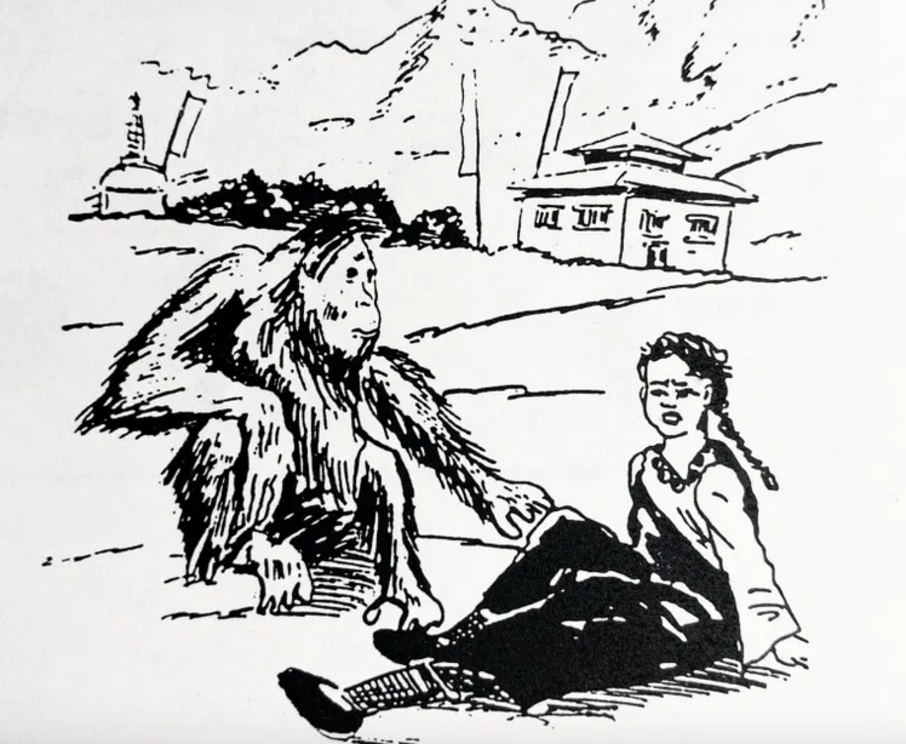A truly abominable snowman
In July 1974, newspapers across the world carried the strange tale of a young woman who claimed to have been assaulted by a Yeti near Machermo, a small village in the Khumbu region of Nepal.
 The Village of Machermo, Nepal. Source: Wikipedia.
The Village of Machermo, Nepal. Source: Wikipedia.
The story that appeared in the Post-Star (Glens Falls, New York) on July 19 was representative of media coverage at the time:
Abominable Snowman Attacks Nepali Girl
Nepal (AP). Nepal’s national news agency reported Wednesday that the Himalayas’ legendary Abominable Snowman had knocked out a teen-aged Nepali girl near Mt. Everest. The agency said the 19-year-old girl claimed the yeti, as the snowman is known among the mountain folk, knocked her unconscious and killed five yaks she was shepherding at a height of 14,000 feet in the Himalayan foothills adjoining Everest.
According to the agency, the female sherpa told district authorities in Namche Bazar, at the foot of Everest, the yeti killed the yaks by twisting their horns around their necks. The agency said she gave this description of the yeti, which so far has defied numerous foreign expeditions that have searched for it as proof that it does exist: “A height of about 4 or 5 feet, covered with thick black hair below the waist and brown hair above. It had thick stout fingers with long nails and its heel was turned forward.”
The girl also claimed the yeti had four feet but could walk faster by using only two feet. According to the news agency, district authorities have gone from Namche Bazar to try to verify the girl’s story.
I remember reading about the Yeti attack at the time and it made quite an impression. There were some red flags, particularly the ‘heel turned forward’ detail which is a classic folkloric element of many wildman legends (including Indigenous Australian stories of the ‘Hairy Man’) as well as the observation that it dropped to all fours. Could it have been a Himalayan bear?

An Illustration of the incident from a contemporary Nepalese magazine. The creature seems to be based on an orang-outan.
Strangely, the case had zero follow up at the time and was soon forgotten. As I rummaged through my own Yeti file this week and came across the story, I decided to try and see if anyone had pursued the case further. I didn’t need to look far!
It appears the Marchermo case was investigated by Nepalese police and wildlife authorities shortly after the incident. A piece in the Nepalese ‘Nepal Nature Conservation Society Newsletter’ No. 28, Issue 2031, February 1975 contained more detail. The author is not noted in my copy:
Yeti at Machermo: Fact or Fantasy?
While photographs, specimens or direct observations are lacking reports of the Yeti or “Sokpa” continue to be made in Nepal. Last July considerable publicity was given to an incident involving a Yeti which was reported to have assaulted a Sherpa girl and then proceeded to kill five Yaks that were grazing in a pasture in Khumbu, north of Khumjung. The controversy surrounding this incident still swirls in the local press, and indeed, among the Sherpas of Khumbu.
During a visit to Khumbu in October, I had a chance to investigate this incident at Marchermo on July 11, 1974. One thing which distinguished this reporting from earlier ones was an official investigation undertaken after the incident. The Police Inspector Ramje Bahadur Khatri dispatched investigator Chatra Man Rai to the scene at Namche Hat Bazaar immediately upon hearing about the incident.
I spoke to both Karki and Rai about the incident and examined their files on the subject. Rai arrived at Machermo some five days after the incident reportedly took place. He found that some of the footprints the creature had left were surrounded by stones. Furthermore many were on the soft sand and hence were easily distinguished. Rai found two types of prints, probably corresponding to the front and rear feet. These prints measured to 1/2” x 4” and 12” x 4” respectively. Rai’s sketches in the file were not carefully drawn, but basically they showed four equally long digits in the shorter print and five equally long, but relatively foreshortened digits in the longer print.
According to Rai, only three Chauri Gais were killed, while others were attacked. The report said that two yaks were killed with punches and one was killed by having its neck broken. Only one of the animals was reportedly eaten by the Yeti.
The sole witness to the event was reportedly Lhakpa Domani Sherpa. The girl was sitting on the big rock near the stream when she heard what she took to be coughing. She looked around and saw a huge black and reddish-brown, monkey-like creature with large eyes and projecting cheek bones. According to the story as told to Rai, the Yeti then grabbed her and carried her to the near-by stream. She was shocked but essentially unhurt. The Yeti let go of the girl but remained in the area for additional thirty minutes or so, during which time it killed or injured the Yaks.
On the basis of these investigations, both Rai and Khatri stop short of concluding that the creature was Yeti, but they seem to rule out the possibility of it being a human being. They feel that while this is the first incident that has been officially reported, similar stories are common and local residents state that anyone visiting Machermo when there is snow on the ground is very likely to see similar prints in the area.
I was unable to locate Lhakpa Domani Sherpa, who was off portering at the time of my visit. I talked with her neighbours and relatives in Khumjung who told me that the Yeti visited the “Yersa” settlement of about 15 low, stone shelters on the gentle part of steep hillside. I even found a Yak head at the location where the incident was reported to have taken place. At the time I was there the settlement was completely deserted.
My own conclusion is that the people involved have no ulterior motives in creating a hoax. In fact if the Yeti is a living creature the prima facie evidence from the incident at Machermo would constitute ample proof of its presence there on July 11, 1974.
It seems the Nepalese authorities were satisfied that something strange had taken place but they weren’t willing to state a Yeti was responsible. Something killed those Yaks, and it wasn’t Lhakpa Domani Sherpa. If it was a bear, why not just call it out?
I asked my good friend and crypto-colleague Tony Healy about the case. Well – Bingo! Turns out that Tony had not only been there and investigated that, but he had documented his adventure in his yet unpublished cryptozoological masterwork, ‘Monster Safari’. As I’ve mentioned in a previous post, Tony travelled the world in the late 70s looking for cryptid’s and his two volume account is a hilarious, entertaining read. I hope it gets published one day.
Tony made a few minor updates for me and here is his account of the case:
According to a story sent worldwide by Reuters news agency in July 1974 a Sherpa woman had recently been knocked down by a particularly nasty yeti, that proceeded to kill several of her yaks. The incident occurred near the village of Machermo, on the western side of the Dudh Kosi. Nepalese police were said to have visited the site, examined the remains of the unfortunate yaks and decided the woman’s story was true.
The lady in question was identified by Reuters as Lapka Domani, but I was told by various people, on reaching the area, that she was usually referred to as Lapkadoma [Cropster: the Nepalese report above states her name as Lhakpa Domani Sherpa] as if her first and second names were run together. That, at least, is how it sounded to me, and how I transcribed her name at the time.

Lhakpa Domani Sherpa, 1979. Copyright: Tony Healy.
After recovering from her ordeal, Lapkadoma married and moved to the larger village of Kumjung, where I was lucky enough to meet her in late December 1979. I was very lucky actually, because she was often away from home for weeks on end during the trekking season, working as a porter. I was fortunate also, in having an excellent, obliging interpreter – a middle-aged man named Ang Tsering – with me when I visited her, in her simple, two-roomed house.
A quiet, pleasant woman of about 25, she seemed honest and unaffected. As we sat around an open fire, she told us that the incident occurred next to a creek, about an hour’s walk uphill from Machermo. During the warmer months, her family usually moved their yaks into the higher country, where she and her brother took turns tending them. As a result, the young woman often spent two weeks or more alone, camped in a very simple hut on site.
On the fateful day – a rainy, foggy day – she heard a sound similar to a man whistling. Thinking it was her brother come to relieve her, she’d climbed onto a rock, whistled back – and then turned to discover a nasty-looking yeti rapidly approaching. While her uninvited visitor wasn’t particularly tall: only about the height of her brother (approximately 5 foot 8 inches), it was tremendously thickset: “as broad as a yak”. It had the well-known pointed head and a small, wrinkled face, “like a very old man’s” and it looked very angry.
She had but a few seconds to stare at the shaggy apparition before it grabbed her by the hair and swung her around. Fortunately, some of her hair pulled out by the roots and she fell into the creek, where she lay, feigning death while listening to the desperate bellows and screams of her yaks. After some time, she couldn’t say how long, she staggered out of the creek bed and found the mangled carcasses of her cattle strewn along the bank.
It looked as if a couple had been hit so hard that the yeti’s fists penetrated right through their thick, hairy hides and also their ribs. Others had broken necks, as if their heads had been twisted right around. Blood and guts were everywhere, but only one small beast appeared to have been partially eaten. (Two other yaks, though injured, survived, and one of them still grazes at Machermo).
In the immediate aftermath, the young Sherpani walked around “like she didn’t know whether she was dreaming or awake”, and was very ill for months afterwards. Her elderly mother confirmed that detail, saying that the family had to call several “big lamas” to the house to cure her.
Although I was very disposed to believe Lapkadoma’s story, I had some reservations about her description of the yeti’s body hair. She indicated it was about four inches long, “not quite red, not quite orange”, that it grew upwards from a bare, belt-like strip around its waist, and downwards below the waist. I thought she’d hardly have had enough time to take in so much detail. I also found the supposedly upward-growing body hair to be quite implausible, even though I knew it to be a standard feature of Nepalese yeti lore. But the young lady had been frightened half to death at the time, and four years had passed since the attack, so she might well have unwittingly embroidered some aspects of her story.
The Machermo Massacre Site
A day or so after interviewing Lapkadoma, my porter Jang Bu and I arrived at Machermo, on the banks for the Dudh Kosi, just below the Ngozumpa glacier. We found it to be little more than half a dozen stone huts, plus a few yak pens and potato patches. It was entirely deserted apart from a single Sherpani who told us, over a few cups of tea, that she was Lapkadoma’s sister. She confirmed that the attack site was about an hour’s walk uphill, beside a creek that runs down from the north-west, passes through the village and joins the Dudh Kosi.
Early the following morning, as I sorted out my day pack and cameras, I found that Jang Bu, who’d trekked all over the mountains since he was a boy, had suddenly developed a very gammy knee, and therefore, sadly, wouldn’t be able to accompany me to the massacre site. He was a great porter and guide, but a lousy actor, and I knew what was up: while guiding me around, cheerfully and efficiently, for several weeks, it had slowly dawned on him that every place I wanted to go had some yeti connection – and he wasn’t at all keen to meet one of those critters. So he hobbled around the hut for a little while, like an arthritic Walter Brennan, grimacing theatrically. Soon, though, being an open, honest soul, he ’fessed-up: “No trekker up there, no people. Danger. I scared.”
As he honestly believed that a yeti sighting always resulted in death or severe illness for the unfortunate witness, I couldn’t really blame the poor bloke for wanting to “chuck a sickie”. In fact, I was feeling more than a bit windy myself at the thought of venturing up the hill.
But I’d come halfway around the world for this – there could be no question of chickening out. So I shouldered my day pack, left a vastly relieved Jang Bu to guard the fort, and set off up the creek. Two or three miles upstream I found what I was looking for: a group of rough summer shelters on the northern side of the gully.
As I wandered here and there, following wolf and fox tracks, and hoping to stumble upon something resembling the Shipton footprints, the whole area became slowly enshrouded in damp, freezing fog. Visibility dropped to just a few feet, and, apart from the strangled gurgling of the creek under the surface ice, all was silence.
As the mist swirled around, ever thicker, I recalled what Lapkadoma said had happened, right there, on just such a foggy morning five years earlier: the whistle, her reply, the furious, rushing rock-ape, the grappling, the fall into the creek, the hideous screams of the dying yaks … the bloody ground … Something her sister said was also running through my mind: that yeti tracks had not only been found in the general area before the attack – they’d also been seen there since.
So as I lurched around the dark, icy site, I was feeling a certain amount of apprehension. Any yeti bursting out of the fog at that moment would have witnessed the rare sight of a shit-scared sahib rocketing 40 feet vertically, leaving socks, boots, pants and long johns smoking on the ground below.
But not a creature was stirring, not even a frost-bitten mouse. So I continued plodding upstream, as the clouds parted, revealing many jagged, black peaks and, in the distance, huge, leaning cliffs of fluted blue ice. From somewhere, far off, came the deep, shuddering boom of an avalanche.
As I stopped, shivering, to gnaw at a lunch of cold potatoes, a large, satanic-looking raven swept in and perched on a nearby boulder. After peering at me for a moment, it squawked evilly, emitting a wisp of vapour from its beak, and flapped away into the wilderness. As it disappeared, I experienced a strong, unsettling feeling of déjà vu, and, feeling suddenly colder, turned and trudged down towards the village.
As Lapkadoma seemed such an open, unassuming person, I felt her report would stand quite well on its own, but my confidence in its authenticity was boosted by some important testimony I collected after I left the high country a few weeks later.

Police Inspector Chatra Man Rai, 1979. Copyright: Tony Healy
Back in Kathmandu I was fortunate enough to meet Police Inspector Chatra Man Rai who, as a sergeant based in Namche Bazar, had been sent up to Machermo to investigate Lapapdoma’s story. A quiet, obliging fellow, he was quite happy to chat.
He said he’d arrived at the village five days after the event, interviewed Lapkadoma, then trekked up to the attack site. There, he examined the dead yaks, verifying their injuries – the ribs punched through, the heads twisted around, etc. – and then actually followed the yeti’s tracks – footprints and occasional handprints – for some distance. His description of the tracks wasn’t particularly detailed – perhaps, after five days, they weren’t very well defined, but I’m sure he didn’t say the feet were reversed, as per Sherpa folklore.
I’m a Believer
It has been suggested that Lapkadoma was actually attacked by a bear that she imagined, in her terror, to be a yeti. But while a bear might be capable of killing a juvenile, crippled or tethered yak, it would be, I believe, impossible for a bear, no matter how hungry or angry, to kill three untethered adults.
There is no doubt that the cattle suffered the massive injuries described by Lapkadoma and her family – Inspector Rei has testified to that – so I have very little doubt that on that foggy day, back in 1974, the young woman really was attacked, not by a bear, but by a particularly abominable snowman.
While the last few decades haven’t improved the case for the Yeti’s existence, Tony is right. Something very strange took place near Machermo on 11 July, 1974.
